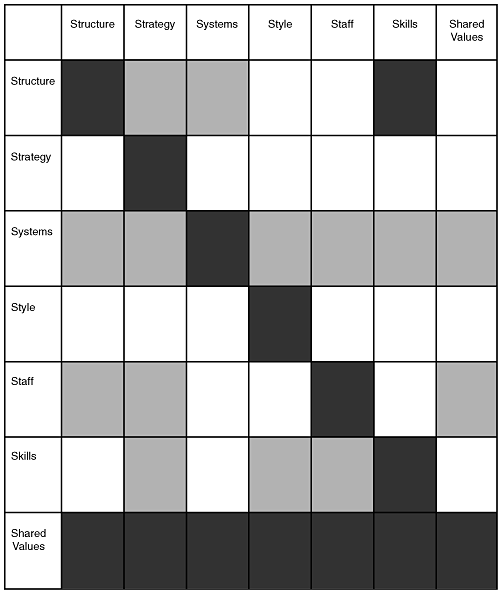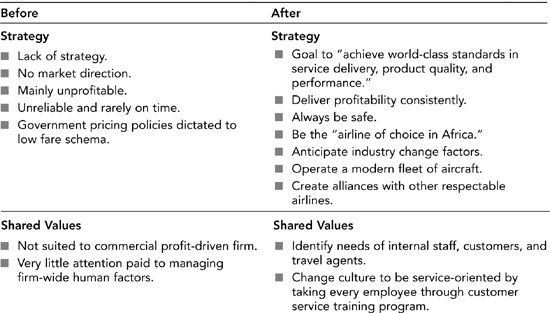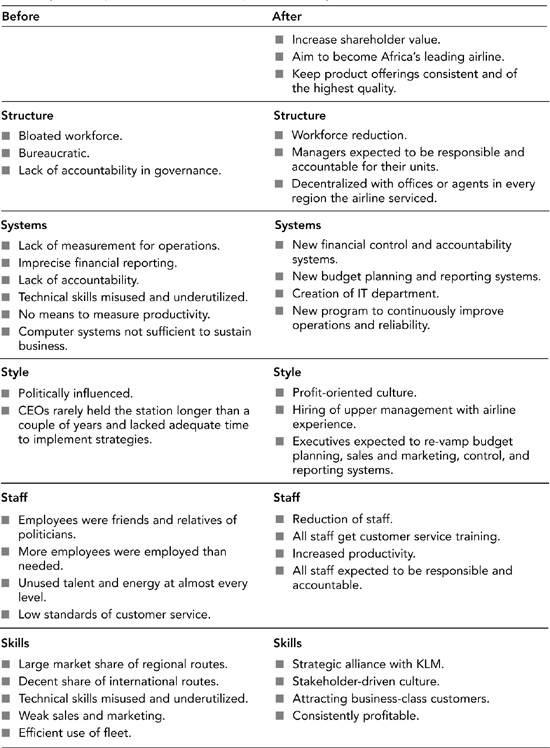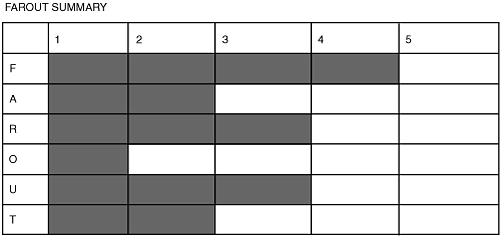12
McKinsey 7S Analysis
Short Description
The McKinsey 7S framework model is a diagnostic management tool used to test the strength of the strategic degree of fit between a firm's current and proposed strategies. It is a management tool designed to facilitate the process of strategy implementation within the context of organizational change.
Background
Implementation has always been the difficult aspect of strategic management. Often the best-laid long-range plans have remained unimplemented because the organizational structure and culture have been lacking. Although modern strategy theory offers the analyst a plethora of different models from which to choose, there is a dearth of implementation methodology. The McKinsey 7S model was designed to fill this vacuum with a conceptual framework to guide the execution of strategy.
In 1978, several consultants at McKinsey & Co.1 codeveloped the McKinsey 7S model. They recognized a circular problem central to their client's failure to effectively implement strategy. The long-held conviction developed by Alfred Chandler in 1962 that organizational structure will follow strategy had been a prominent concept in modern strategy theory.
Most strategies implicitly incorporate the assumption that structure follows strategy but offer no execution guidance with regard to organizational structure. Because implementation is equally important as conception, many strategies failed.
The McKinsey 7S model challenged this implicit assumption by suggesting that the "structure follows strategy" paradigm was not that at all; rather, not only must structure be actively managed, it must be supplemented with equal concern for organizational effectiveness as a whole.
The McKinsey 7S model specially addresses the need to build a tight strategic fit between strategy, organizational structure, and five additional components of organizational effectiveness. Successful implementation of strategy requires explicit management of the interrelationships between these seven elements. These seven elements of organizational design and effectiveness are discussed next:
- Structure—The familiar organizational chart is a suitable proxy description of structure. Structure involves the reporting of relationships within a firm as well as the division and integration of tasks. The choice of structure involves a myriad of tradeoffs. For example, a firm's structure may be centralized or decentralized, hierarchical or flattened, specialized or integrated, or autonomous or outsourced. The focus on structure within the McKinsey 7S model, however, concentrates especially on two aspects of the realm of structure. First, the idea of the coordination of all the aspects of structure in the support of strategy is prominent. Second is the need to isolate those aspects that are critical to successfully managing and negotiating change in industry evolution and new or revamped strategies.
- Strategy—Among the many formal definitions of strategy, there are several common, dominant themes.
Strategy is the set of competitive responses manifested through decisions and actions in response to the firm's environment. Strategy aims to best position the firm's current capabilities and resources in a competitive marketplace to secure competitive advantage over time. Because the firm's environment is constantly in a state of flux, so too must strategy change to protect and project existing sources of competitive advantage.
In addition, strategy must be designed to seek out new external opportunities and acquire or internally develop the requisite resources and capabilities to exploit these environmental changes into new sources of competitive advantage. The focus on strategy within the McKinsey 7S model is not on developing new strategies or protecting existing ones; rather, its inclusion underscores the core theme of the model that asserts that strategy conception and formulation has been well managed in many firms due to its emphasis through decades of reinforcement in business schools and in the now-voluminous strategy literature. Problems in the other six elements are more often the cause of ineffective implementation. - Systems—Systems encompass the flow of both primary and secondary activities that are important to the firm's daily functioning. These include core processes (for example, product development and operations management), as well as support activities (for example, information systems, accounting, and human resources). The important distinction that the McKinsey 7S model makes with regard to systems is that changing systems is often a much less disruptive and more effective route to enhance organizational effectiveness, as opposed to the more traditional levers of manipulating strategy or structure.
- Style—Style refers to the actions and behavior of senior executives, rather than what they say. As such, the conduct of top management is an extremely valuable management tool that conveys and reinforces strong messages to stakeholders, and particularly employees, throughout the organization. One of the most important barometers of executives' behavior is the way in which they spend their time. By concentrating their individual and collective attention on managing critical success factors, executives can help their staff prioritize the essential activities that the organization must perform well. Another important barometer of style is symbolic or signaling behavior that can be seen as constantly reinforcing the fundamental value system of the company. By fostering a firm-wide "strategic conversation" composed of formal and informal symbols, top executives instill a positive culture consistent with the firm's strategic intent.
- Staff—The human resources of a firm are its most valuable strategic asset. The staff element includes both remuneration (compensation, incentives, and reward) and softer, more qualitative, motivational considerations. Specifically, in the 7S model, management attraction, recruitment, and development of employees are important to organizational effectiveness. Equipped with the organization's culture and core values, managers will hopefully spend fruitful careers fostering these attributes to staff located in all parts of the firm. In this regard, putting young managers in positions of authority close to the executive suite, with legitimate responsibility for some critical aspect of the firm's business model and opportunities for advancement, will positively impact long-term organizational effectiveness. By paying special attention to engaging the firm's future executives in all seven elements of the model, the firm's future organizational effectiveness can be successfully propagated.
- Skills—The raw material of sustainable competitive advantage often lies in the intangible core competencies or skills of its people. The McKinsey 7S model focuses on skills because environmental change infers not only a change in strategy, but also an accompanying change in the skill set of a firm's human resources. Successful organizational change often requires increased investment to acquire or develop new skills, along with reduced investment in the established skill set that was more closely attuned to the old business models. This transition toward new skills is a process that, if done poorly, will thwart the cultivation of conditions necessary to grow new organizational skills.
- Shared values—Sometimes also referred to as "super-ordinate goals," shared values represent the collective value system that drives a firm's organizational culture. Often, shared values are informal and go beyond the company's mission statement by encompassing intangibles such as strategic intent, underlying beliefs, mental mindsets, and future direction. Within the 7S model, shared values are commonly seen as the most fundamental building block of an organization, thereby providing a foundation for the other six elements. Often, shared values are short articulations of the essential meaning or driving force of the company. The difficulty, and hence value, of creating strong shared values within an organization is exemplified by the observation that only exceptional firms are able to consistently leverage this phenomenon over time.
Figure 12.1 is a schematic representation of the McKinsey 7S framework. This diagram identifies the significant cross relationships of the seven elements of organizational effectiveness.

Figure 12.1 The 7S framework model2
There are four key insights that can be derived from this model. First, Figure 12.1 identifies the five other elements comprising organizational effectiveness in addition to the traditional strategy and structure dualism; namely, systems, style, staff, skills, and shared values.
Second, the lines connecting each element identify the mutual dependency between each element of organizational effectiveness. Pulling one lever, as it were, will cause a ripple effect across the whole system. It is this concept of holistic interrelationships that runs through the most fundamental units of the organization.
The third insight is the assertion that strategic failure may well be attributable to inattention to any one, or a combination of, the seven elements of strategic fit. This framework provides a corrective lens for the strategic myopia that often leads to inappropriate structure or poor strategy in the first place.
The fourth insight comes from the shape of the diagram—the circular consistency of the model focuses the analyst's attention on the absence of hierarchical dominance. It encourages the analyst to conclude that no one element is more important than the others—each element is a necessary but insufficient condition for organizational effectiveness. However, in some scenarios, one factor may figure more prominently than the rest. This lack of precision and high level of abstraction makes the McKinsey 7S model very flexible.
Taken together, these four insights have made an enormous contribution to modern strategy theory in two powerful ways. First, the McKinsey 7S model introduced the importance of the qualitative factors of organizational effectiveness to counterbalance the almost exclusive focus on strategy and structure that pervaded previous thought around the management of organizational change. Second, it pushed the conceptual envelope away from an external environmental preoccupation to a more holistic appraisal that includes a more realistic appreciation of the whole system—that is, both the organization acting on its environment, as well as the environment acting on the organization.
Strengths and Advantages
The 7S model pays particular emphasis to a firm's strategy implementation. This key facet of the traditional strategic management model was often given short shrift or even ignored in many preceding management constructs. The McKinsey 7S model filled this analytical vacuum by suggesting that strategic success in the competitive marketplace is also dependent on organizational effectiveness. This counteracted the disproportionate emphasis of previous models on external, economic, and marketplace factors. The McKinsey 7S model laid the groundwork for the increasing prominence of organizational dynamics in future models, such as core competency and resource-based theories.
Further, the 7S model developed the concept that organizational effectiveness was not dependent on just strategy and structure—a radical and much-needed departure from the confines of the decades-old (although admittedly still vibrant) "structure follows strategy" paradigm. The inclusion of the other elements of strategic fit broaden the analyst's scope to consider the possibility that for select firms, the reality of their context will be that strategy follows structure. At any rate, the analyst will soon realize that organizational change requires strategic management of all seven elements of strategic fit, not just tinkering with one or two of the elements (traditionally only strategy and structure).
The greatest strength of the 7S model is in its comprehensiveness. Because the analysts must consider each of the seven broad-ranging constructs, as well as how each of them interacts with one another, they are unlikely to miss any potential gaps that may arise out of changed strategies or their implementation. This model is also one of the first to actually compel the analyst to consider strategy implementation simultaneously with strategy development. These issues tended to be separated before the time of this model's introduction and popularization.
The 7S model was also one of the first to meld consideration of the "hard" (e.g., strategy, structure, and systems) and "soft" (i.e., shared valued, skills, staff, and style) aspects of the enterprise. Most models before this one tended to focus most heavily on one side or the other, to the exclusion of the ignored side of the equation. The 7S framework is valuable in supporting management thinking when implementing strategy and facilitating needed organizational changes.
The 7S model also emphasizes to the analysts and their managers the need to coordinate key tasks within the organization. The challenge lies in focusing on those dimensions that are important to the organization's evolution. The organization must be able to refocus and reallocate efforts as crucial dimensions shift.
The 7S model was also one of the first to help connect academic research with managerial practice. In particular, it emphasized how important shared values or corporate culture were in keeping the organization in synch and in driving the successful execution of smart strategies. A critical result of this model was that enterprises could be viewed as independent social systems—whose artifacts in the form of rituals, stories, symbols, and stated and exhibited values—create a powerful influence on employee behavior and can be the difference between an organization operating in an empowered fashion versus one that requires additional layers of bureaucracy to achieve its aims. This model would lead to a stream of subsequent academic research that has continued to inform consultants and managers to this day.
Weaknesses and Limitations
The primary weakness of the 7S is directly related to its greatest strength. Because the 7S requires the analyst to consider not only the seven independent constructs, but also their interrelationships, the analyst may miss some fine-grained areas in which gaps in strategy conception or execution can naturally arise.
There is little empirical support for the model or of its originator's conclusions.3 Indeed, several years after the model was popularized by Peters and Waterman in their best-selling 1982 book In Search of Excellence, most of the companies that were highlighted had suffered from poor performance and were no longer the paragons of excellence that had been originally touted.
Despite the model's clear emphasis on looking inward at organizational factors and fits, it remains difficult to properly assess the degree of fit, particularly between strategy and the other elements. Strategy is the clear linking pin that should align the other elements, but this is far more complex to achieve in practice than a single construct can suggest.
It is also difficult for analysts to explain, in practical terms, just exactly what should be done for implementation in terms of using the model. The model encourages the analysts to consider the many interactions, but does not require them to consider the many different options available for changing interrelationships among the seven concepts or most importantly, specify what order or sequence within which the needed changes should be made.
The 7S is mostly a static model. It is useful for looking at a snapshot of the fit among the seven constructs at any single point in time; consequently, it can be difficult to use in recommending changes to relationships among the constructs over time, unless the model is developed, analyzed, and applied on an ongoing basis—something that is rarely, if ever, done in practice due to the pragmatic considerations of time and effort required to effectively accomplish this outcome. As such, the model's ability to address the challenges generated by dynamic enterprises and marketplaces is more limited than those models that expressly and explicitly account for time as a critical variable.
Process for Applying the Technique
The process for applying the McKinsey 7S model can be quite simple. However, it is easy to overestimate the firm's ability to achieve alignment among all seven elements of organizational fit. The 7S model can also be used to test both current and proposed strategy and, as such, assumes that these strategies have already been conceptualized and formulated.
The first step is to analyze the individual components of the McKinsey 7S model—that is, to closely examine each "S." The key success factors for each element as they pertain to the firm's current and/or future strategy need to be identified. Some experts recommend that a 7 x 2 matrix be composed, with the top row containing the critical features of each "S" that the company does extremely well. Correspondingly, the bottom row would contain the elements of each "S" in which the company is achieving subpar performance. This matrix can be extremely useful in organizing the analysis. It forces the analyst to not only explicitly isolate key action variables but also to determine the distance between what the company is currently doing well and what it needs to do well in order to successfully implement the strategy.
After isolating the strategic distance between the seven elements of strategic fit, there are essentially three options:
- The firm can work to change the required components of each "S" so that they are consistent with strategy.
- It can change the strategy to fit the existing orientation of the other six elements of the model.
- Often, a compromise between each option is the realistic alternative.
After the choice of actions have been decided upon, the model should reflect an alignment between each of the seven elements of organizational effectiveness—that is, strategy, structure, style, skills, staff, systems, and shared values should be moving forward in the same direction.
Figure 12.2 depicts a prototypical application of the 7S framework. The boxes that are shaded the darkest are ones in which the two common elements are in alignment. Boxes shaded in gray are ones in which there is a partial alignment between the two conjoined elements. Boxes that are unshaded (i.e., white) exhibit misalignment between the two elements. The McKinsey 7S model asserts that organizations should seek alignment between all of the elements, and the areas identified as being misaligned (i.e., the white and grey shaded boxes) become the prime targets for managerial intervention and correction. The 7S model asserts that this alignment is a necessary condition for the successful implementation of strategy.

Figure 12.2 Grid showing state of "fit" between seven "S" elements at one point in time
Case Study: Privatization of Kenya Airways in the New Millennium
The 1960s were supposed to be a time of betterment and growth in Sub-Saharan Africa. The area was completing the decolonization process, and governments were creating new state-owned enterprises (SOEs) to lead their respective economies in major industrial, structural, and social improvement. However, these optimistic visions failed to materialize, as most SOEs were poorly run and almost never profitable. By the 1980s, problems stemming from massive state intervention and a lack of market forces led to economic disaster.
Consequently, external pressures have forced these countries to fight against dictatorship and authoritarianism in favor of democracy and privatization.
Kenya Airways was originally established in 1977 as a corporation owned by the Kenyan government. Senior management was appointed by politicians and had virtually no airline experience. The company lacked structure and direction, had very little equipment (seven planes), and was burdened with high interest foreign currency loans. By 1991, the airline was losing market share due to poor service and unreliable flight schedules, and its debts were an enormous strain on the Kenyan government. The only way to turn the fledgling airline toward profitability, it seemed, was to privatize it.
In 1991, the commercialization process began in order to prepare the airline for privatization. A new and capable management team was hired and given complete autonomy to restructure the company. Research was conducted to identify the needs of all stakeholders, and an IT department was created to introduce new, consistent systems and controls for accounting, scheduling, operations, management, and ticketing. By 1994, the airline recorded its first profits and in 1995 created a strategic alliance with KLM Royal Dutch Airlines. In 1996, the Kenyan Government sold 26% of its stock to KLM, and most of the remainder of its stock to the Nairobi Stock Exchange, leaving only a 22% minority ownership block held in the airline.
Privatization had forced Kenya Airways to become a self-sustaining profit-generating firm. It could no longer rely on government protection or bail-outs.4 To successfully negotiate these challenges, Kenya Airways was required to assess threats and determine how to manipulate the seven elements of strategic fit to first survive the turmoil, and second to eventually prosper in a new competitive environment (see Table 12.1).
Table 12.1
McKinsey 7S Comparison of Pre- and Postprivatized Kenya Airlines


Source: Tiller, 1997; Debrah and Toroitich, 2005; Major Milestones: Kenya Airways Global Website, 2006.
FAROUT Summary

Figure 12.3 McKinsey 7S analysis FAROUT summary
Future orientation—Medium to high. The McKinsey 7S model is forward looking in that it is oriented toward future implementation of proposed strategy or correction of existing organizational effectiveness to maximize the effectiveness of current strategy.
Accuracy—Low to medium. Accuracy depends on the ability of the analyst to: (a) correctly diagnose the seven elements and their interactions; (b) correctly diagnose the key success factors; and (c) implement the required changes to close the distance between (a) and (b).
Resource efficiency—Medium. This depends on the depth of analysis and the number of analysts engaged. Similarly, the comprehensiveness of internal consulting will dictate resource efficiency.
Objectivity—Low. The requisite analysis is highly qualitative and subject to perception bias.
Usefulness—Medium. The explicit purview of this model draws attention to what many other models ignore. As such, the McKinsey 7S model is compatible with, and complementary to, a good number of other management tools and techniques.
Timeliness—Low to medium. A comprehensive McKinsey 7S model analysis is extremely comprehensive and covers all facets of the firm. Additionally, correctly examining the intricate interrelationships between the seven elements can require a substantial amount of time.
Related Tools and Techniques
- Competitive benchmarking
- Customer segmentation and needs analysis
- Customer value analysis
- Functional capability and resource analysis
- SERVO analysis
- SWOT analysis
- Value chain analysis
References
Chandler, A.D. Jr. (1962). Strategy and Structure: Chapters in the History of the American Industrial Firm. Cambridge, MA: MIT Press.
Darden Graduate Business School Sponsors (1983). American Telephone and Telegraph (A). Charlottesville, VA: University of Virginia.
Debrah, Y.A. and O.K. Toroitich (2005). "The making of an African success story: The privitization of Kenya Airways," Thunderbird International Business Review, 47(2), pp. 205-230.
Hax, A.C., and N.S. Majluf (1983). "Organization design: A case on matching strategy and structure," The Journal of Business Strategy, Fall, 4(2), pp. 72–86.
Major Milestones at a Glance, Kenya Airways Global Website, accessed September 28, 2006 at http://www.kenya-airways.com/kq/kqdispinfo.aspx?colm=69.
Pascale, R. Managing on the Edge. London, UK: Penguin.
Peters, T.J. (1984). "Strategy follows structure: Developing distinctive skills," California Management Review, Spring, 26(3), pp. 111–125.
Peters, T.J., and R. Waterman (1982). In Search of Excellence. New York, NY: Harper and Row.
Powel, T.C. (1992). "Organizational alignment as competitive advantage," Strategic Management Journal, February, 13(2), pp. 119–134.
"Privatization of Kenya Airways" (2005). Thunderbird International Business Review, March–April, 47(2), pp. 205–230. http://www.kenyaairways.com/root/pages/English/Home.asp (September 8, 2005).
Tiller, M. (1997). "A first for Africa: The privatization of Kenya Airways," Economic Perspectives: USIA Electronic Journals, 2(1), January, accessed September 28, 2006 at http://usinfo.state.gov/journals/ites/0197/ijee/ej5case.htm.
Waterman, R.H. Jr. (1982). "The seven elements of strategic fit," The Journal of Business Strategy, Winter, 2(3), pp. 69–73.
Waterman, R.H. Jr., Peters, T.J., and J.R. Phillips (1980). "Structure is not organization," Business Horizons, June, pp. 14–26.
Endnotes
1 Waterman, R.H., Peters, T.J., and J.R. Phillips.
2 Based on Peters and Waterman (1982).
3 Pascale, 1990.
4 Tiller, 1997; Debrah & Toroitich, 2005; Major Milestones: Kenya Airways Global Website, 2006.
